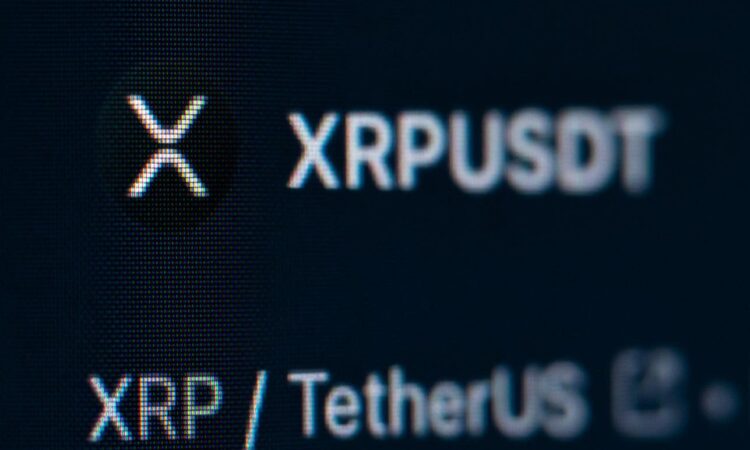
XRP is one of the most discussed and traded digital currencies online. What lies ahead for XRP in … [+]
Few digital assets spark as much debate as XRP. Some see it as the future backbone of cross-border payments: faster and more cost-effective than traditional methods, while others question its underlying value and long-term viability. Uncertainty surrounding XRP’s regulatory situation and its close association with the fintech company Ripple only adds to the intrigue. Yet, beyond the controversies, one undeniable reality remains: XRP is among the largest cryptocurrencies by market capitalization, and any potential shift in its utility can significantly impact its price.
In this article, we’ll explore the fundamental question of what truly gives XRP its worth, examining how Ripple’s ongoing forays into central bank digital currencies (CBDCs), stablecoins and other initiatives could shape the token’s trajectory. While a hint of skepticism is warranted, especially amid fierce competition and mounting legal scrutiny, there are genuine signals that XRP’s use cases may continue to expand. Ultimately, the goal is to offer a balanced view of the forces propelling XRP forward and the obstacles that may stand in its way so that readers can form a clearer perspective on its price outlook through 2025.
Understanding The Current State Of XRP
Before delving deeper into XRP’s price dynamics, it’s helpful to understand how Ripple itself operates. Ripple is a fintech company that provides software solutions for cross-border payments, primarily targeting financial institutions and payment providers. Instead of relying on potentially slow, expensive bank-to-bank transfers, Ripple offers an alternative settlement infrastructure, RippleNet, that aims to reduce transaction times and fees by leveraging blockchain technology. Ripple’s clients include several financial players, including major banks and remittance operators, who seek faster, more efficient ways to move money across borders.
Where XRP fits into this picture is as a bridging asset on RippleNet. In theory, XRP can be used to source liquidity on demand, letting financial institutions convert one currency into XRP and then from XRP into another currency, all in near real-time. This on-demand liquidity (ODL) model can appeal to firms looking to free up capital otherwise tied up in pre-funded accounts worldwide. However, not all of Ripple’s partners choose to use XRP, some may use Ripple’s software suite without relying on the token. Whether the market and regulatory environment will favor widespread adoption of XRP in these cross-border channels remains one of the biggest unanswered questions shaping its future value.
The Skeptic’s Perspective On XRP’s Value
One of the most frequently leveled criticisms at XRP is its somewhat opaque relationship to Ripple, the fintech company behind much of XRP’s enterprise adoption. For purists in the crypto community, the reliance on Ripple’s business development and partnerships raises doubts about XRP’s actual decentralization. They question whether market demand for XRP is organically driven by real-world usage or primarily sustained by speculation and promotional campaigns. Ongoing regulatory scrutiny has only magnified this tension, especially in the United States, where debates persist over whether XRP should be classified as a security.
Adding to the skepticism is the concern that XRP’s purported use cases, namely, cross-border payments and liquidity solutions, are increasingly contested by emerging stablecoins and even central bank digital currencies (CBDCs). Critics argue that if national monetary authorities release their own digital currencies or private stablecoins continue to capture market share, the utility of XRP might diminish. This prompts a key question: if Ripple’s technology can function just as effectively with other digital assets or fiat-backed instruments, will XRP remain integral to the broader vision Ripple has laid out? For now, that doubt underscores why many investors remain uncertain about the token’s intrinsic value, demanding more concrete evidence of sustained, widespread usage.
Ripple’s Ecosystem Expansion
Ripple’s value proposition extends well beyond simply facilitating cross-border payments. Over the years, the company has sought to fortify the XRP ecosystem through various initiatives, from forging partnerships with traditional banks and remittance providers to investing in blockchain start-ups that could integrate XRP into their platforms. Proponents argue these strategic moves signal Ripple’s commitment to broadening XRP’s utility, offering real-world backing for its perceived value.
Yet, for all the headline-grabbing announcements, the actual market adoption of XRP’s liquidity solutions can be difficult to figure out. While Ripple has released pilot programs related to central bank digital currencies (CBDCs), there is no guarantee these efforts will translate into widespread usage of XRP itself. Indeed, some central banks exploring Ripple’s technology may opt to build proprietary digital tokens or use stablecoins backed by fiat, thus sidestepping the need for a volatile cryptocurrency. Nevertheless, these partnerships and proofs-of-concept underscore the potential for XRP to evolve alongside new financial infrastructures, if that is, Ripple can convert interest into concrete demand for XRP-based solutions.
Key Factors Influencing XRP’s Price in 2025
A few factors will likely shape XRP’s market performance in 2025. While the token’s price is partly driven by general crypto sentiment, certain XRP-specific developments carry significant weight, especially given Ripple’s active role in expanding its use cases and engaging with regulators. Below are four key factors that could determine whether XRP experiences another surge or faces continued headwinds in 2025.
Regulatory Clarity
Perhaps the most urgent question for XRP is how it will fare under shifting regulations, particularly in the U.S. Ongoing legal battles, including those involving Ripple and the Securities and Exchange Commission (SEC), could establish precedents that either encourage or stifle institutional usage of XRP. A favorable ruling may propel new listings on major exchanges, while an adverse outcome could limit access to both retail and corporate investors.
Institutional Adoption
Beyond regulatory considerations, real-world adoption by banks, fintechs and payment processors is essential for XRP’s longevity. Ripple’s partnerships, pilot projects and the integration of XRP into liquidity solutions all matter here. If these entities use XRP for cross-border remittances or treasury management, the token could gain steady transactional volume, potentially stabilizing price fluctuations. However, if companies opt for private, permissioned versions of the technology that bypass XRP, its demand could stall.
Technological Advancements
XRP’s speed and typically low transaction fees are often touted as major advantages. Yet the broader crypto landscape continues to evolve, with new blockchains and Layer-2 solutions vying for dominance. Ripple’s development roadmap must keep pace to remain competitive, whether through protocol upgrades that enhance scalability and privacy or by building interoperability bridges that connect XRP to other major blockchains. Such innovations can reinforce investor confidence and stimulate new use cases.
Market Trends
As with most digital assets, XRP’s price is also influenced by broader economic and crypto market conditions. Factors like global interest rates, inflation and investor risk appetite often drive capital flows into and out of cryptocurrencies. Bull markets could accentuate any positive developments around XRP, while economic downturns or crypto-specific bear cycles may overshadow even the most promising Ripple initiatives. Keeping a close eye on macro signals is crucial for anyone looking to understand XRP’s price trajectory.
Analysts’ XRP Price Predictions for 2025
At this stage, XRP’s path forward looks far from linear. A variety of outcomes, both bullish and bearish, will hinge on how effectively Ripple can convert its partnerships, regulatory battles and technology upgrades into tangible adoption of XRP. While no single factor will likely make or break XRP’s prospects, the interplay between regulatory clarity, institutional usage and broader market cycles could propel the token in different directions.
Bullish Possibilities
- Mainstream Financial Integration: If Ripple’s cross-border solutions gain traction among leading banks, payment platforms and remittance providers, recurring transaction volume could make XRP an essential liquidity tool.
- Positive Legal Precedents: A decisive legal victory or regulatory framework that affirms XRP is not a security could see it relisted on major U.S. exchanges, potentially attracting new retail and institutional investors.
- Success in CBDC Collaborations: Ripple’s pilot programs with central banks might evolve into fully-fledged systems leveraging XRP. Should central banks adopt XRP for liquidity or bridging different digital currencies, the token’s market share could be dramatically expanded.
Bearish Possibilities
- Regulatory Setbacks: Ongoing legal disputes could end unfavorably, limiting XRP’s U.S. market access or imposing restrictions that diminish its global competitiveness.
- Competitive Pressures: Rapidly evolving stablecoin projects and next-generation blockchains, offering equal or greater speed and cost efficiencies, may outpace XRP in key corridors, eroding its unique selling points.
- Investor Apathy: Prolonged uncertainty and slow development of use cases might cause both retail and institutional investors to lose confidence, reducing trading volume and liquidity over time.
Consensus View
In reality, XRP’s price trajectory may fall somewhere between these extremes. Even a moderately positive resolution of regulatory issues and a handful of successful implementations in cross-border payments or digital currency initiatives could sustain, and potentially boost, XRP’s market presence. Conversely, a sequence of unfavorable legal outcomes or missed opportunities in the face of rising competition may see XRP struggle to recapture past highs. The key takeaway is that XRP’s long-term value depends less on headlines and more on definitive, widespread usage that validates its role in the evolving financial ecosystem.
Opportunities For XRP Growth In 2025
XRP’s Role in CBDCs
Ripple’s ongoing exploration of Central Bank Digital Currencies (CBDCs) and stablecoin initiatives represents a potentially game-changing frontier for XRP. The core premise is that XRP’s infrastructure could serve as a bridge currency, smoothing transactions between newly launched digital fiat currencies and existing crypto assets. If various central banks worldwide roll out their own digital tokens, a neutral settlement asset like XRP might unify these disparate systems by facilitating near-instant cross-border transfers. In that scenario, Ripple’s established relationships with financial institutions could lend XRP additional credibility, making it more attractive to risk-averse partners and potentially enhancing liquidity.
Increasing Global Adoption
However, significant challenges remain. Many central banks may develop closed-loop systems or issue fiat-backed digital currencies rather than rely on a volatile third-party token. Likewise, private sector stablecoins could gain the trust of corporations and government entities by demonstrating strong regulatory compliance and minimal price fluctuation, reducing the perceived need for XRP. Collaborations with policymakers also demand stringent oversight. Any lingering legal or structural uncertainty surrounding XRP could deter central banks from integrating it directly into their digital currency frameworks. While the opportunity for XRP to act as an intermediary in a rapidly evolving digital financial system is compelling, Ripple must prove that the token’s speed, cost-efficiency, and interoperability justify its inclusion over less volatile alternatives.
Will XRP’s Price Rise or Fall in 2025?
XRP’s price potential ultimately hinges on its ability to demonstrate genuine utility in the face of formidable competition and frequent bouts of regulatory uncertainty. While the token’s performance has traditionally followed the broader ebbs and flows of the crypto market, XRP’s fate is more closely tied than many realize to Ripple’s ongoing legal entanglements and its success in persuading banks, fintechs, and payment processors to integrate XRP for real-world transactions.
Investors who believe in XRP’s long-term prospects may point to the ongoing development of cross-border payment solutions, pilot CBDC initiatives, and attempts to cultivate stablecoin partnerships as signs that Ripple is committed to solidifying XRP’s place in the global financial infrastructure. However, skepticism remains justified, as it is unclear whether governments, central banks, or large corporates will embrace an externally managed asset like XRP over proprietary or fully fiat-backed systems. Consequently, XRP’s near- to mid-term pricing will likely be a barometer for its actual adoption; if transaction volumes remain modest and legal challenges persist, it may struggle to maintain bullish momentum. Conversely, visible progress in regulatory resolutions and corporate usage could help stabilize the token’s reputation and foster renewed investor confidence.
Bottom Line
XRP’s ongoing journey straddles the line between ambitious, real-world adoption goals and doubts about its utility. Regulatory clarity, significant institutional partnerships and meaningful use cases, particularly concerning CBDCs and stablecoins, remain pivotal to shaping the token’s trajectory. While some see a streamlined, widely adopted liquidity tool on the horizon, others await more concrete evidence before considering XRP a sustainable, long-term value proposition.
For investors, the key lies in watching the data behind the headlines. Actual transaction volume, corporate integrations, and evolving regulatory positions will speak louder than market hype alone. Should Ripple successfully convert partnerships into tangible growth opportunities, XRP could see its role expand in the broader crypto market. If not, the crypto landscape’s rapid innovation and stiff competition may eclipse XRP’s once-promising narrative, leaving skeptics with the last word.



